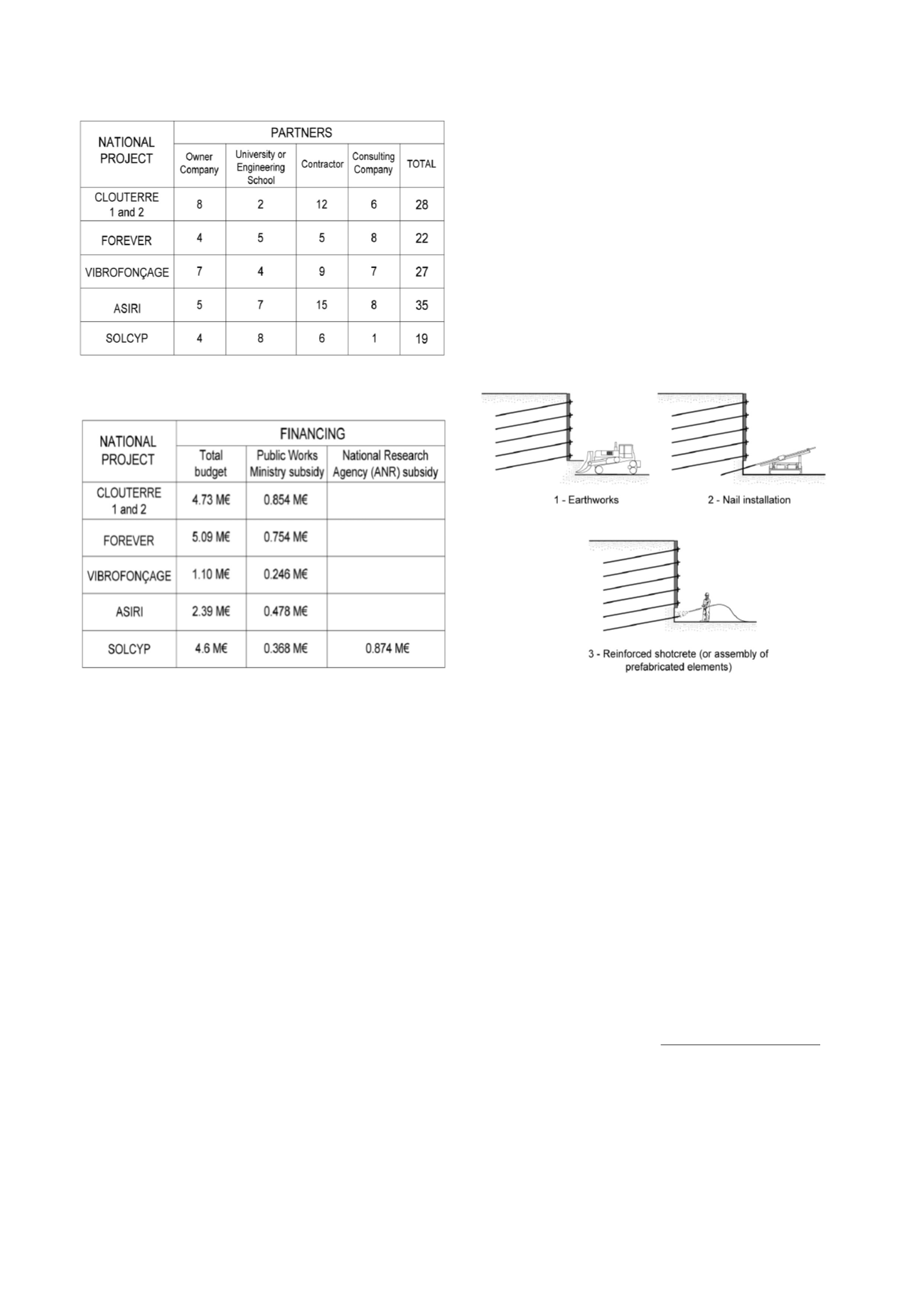

Proceedings of the 18
th
International Conference on Soil Mechanics and Geotechnical Engineering, Paris 2013, volume 6, 2016
Table 1: Distribution of partners in the geotechnical National Projects
Table 2: Financial amounts involved in geotechnical National Projects
A few specific aspects of these National Projects are worth
noting:
1) In light of the recent creation of the National Research
Agency (ANR), overseen by the Ministry of Research, several
projects have benefited from ANR subsidies for laboratory
research, whereas more full scale experimentation-oriented
projects were granted the Public Works Ministry subsidy (see
Table 2). Collaboration among the various partners however has
remained steady and is always considered fruitful.
2) Although the word "National" might suggest that only
French partners are asked to participate, several National
Projects in geotechnical engineering have included foreign
partners. More specifically, the Quebec Transport Ministry
partnered in the CLOUTERRE project, and the U.S. Federal
Highway Administration and University of Canterbury (New
Zealand) were among the partners to the FOREVER project.
Moreover, as of 1991, this National Project process started
attracting the interest of other international partners: Canada's
Federal Ministry of Research in 1991, then its counterpart in
China (1992), and more recently a Japanese mission in France.
3) From the outset, the Works French Federation of Public
Works Contractors has been a key actor behind these National
Projects. Also, the contractors , despite being in a competitive
sector, were able to join forces and find common paths for not
only updating their technical doctrines, reference guides and
rules, but also for applying outcomes to help develop their
activities abroad.
4) The National Projects movement has enabled public and
private sector engineers to collaborate in research pursuits and
develop bonds, breaking with the past when such opportunities
were few and far between.
4
THE "
CLOUTERRE
" NATIONAL PROJECT
4.1
Project objective and characteristics
The goal of this National Project was to promote the soil nailing
technique, especially within the scope of permanent retaining
walls, by means of: accumulating in-depth process knowledge,
determining process limitations, devising reliable design
methods, and issuing recommendations. All these points were to
be advanced by drawing upon full-scale experiments.
As a matter of fact, a few years after publication of the 1991
CLOUTERRE Recommendations, it became necessary to extend
the results of the CLOUTERRE I NP by carrying out research on
walls and other structures featuring nailed soils, notably by
developing a design method at the serviceability limit states
(SLS), as derived from a set of finite element calculations. This
step gave rise to the CLOUTERRE II National Project, whose
research was performed from 1995 to 1999.
Fig. 2: The 3 phases of retaining wall construction by
in situ
soil nailing
As shown in Figure 2, the nailing technique used to erect a
retaining wall constitutes an extension of the Reinforced Earth
technique, with the first major structures being built in 1968-69
for the motorway between Nice and Menton, whose 23-m high
Peyronnet
wall has remained firmly intact. As opposed to the
Reinforced Earth technique however, construction proceeds from
top to bottom, which considerably alters the sequencing and
complicates execution. More specifically, the earthworks phase
at the base of the section of wall already built may, if the wall is
too high and/or left standing during a several-day suspension of
works, induce failure.
As mentioned above, the
Clouterre I
NP comprised 22
partners, including the Quebec Transport Ministry. It took place
between 1986 and 1990, with a budget totaling €3,150,000, 15%
of which was financed by France's Public Works Ministry and
the balance provided by project partners in the form of dues and
in-kind contributions.
4.2
The CLOUTERRE I full-scale experimental campaign
At the CEBTP Center's St Rémy-lès-Chevreuse experimental
site, it was possible to conduct three full-scale experiments on
nailed soil walls built in Fontainebleau sand masses, with well-
controlled parameters. These experiments will be briefly
described below.
Volume 6 - Page 77









